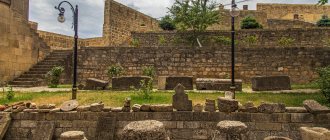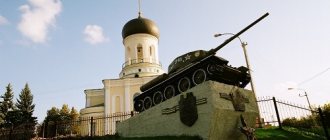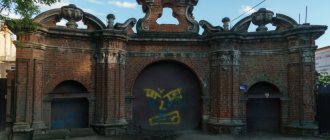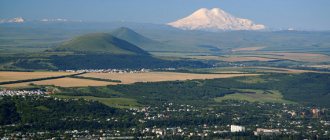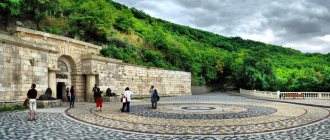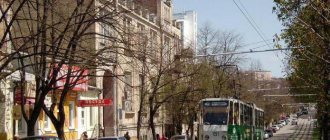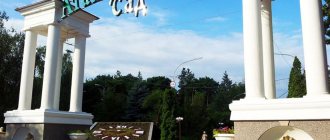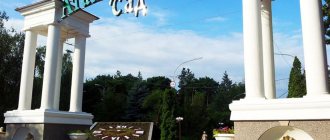| What to see on your own Museums Stories, routes and tips from tourists Where to go for 1 day Where to stay in Pyatigorsk Interesting excursions |
Pyatigorsk is the oldest balneological and mud resort, famous for its healing mineral waters. The hot mineral springs of Mount Mashuk were first explored at the end of the 18th century, and the city dates back to that time. Water treatment is complemented by the healing mud of Lake Tambukan , mountain air and a favorable climate.
To get to know the city, people usually come to Pyatigorsk for several days. During the standard two-week treatment period, resort guests have the opportunity to leisurely get acquainted with all the iconic objects of the resort. As a rule, vacationers from neighboring resort towns or business travelers who have taken a day off from official business come for one day.
What to see in Pyatigorsk in 1 day on your own
Pyatigorsk is the largest and most tourist-rich of the resort towns of the Caucasian Mineralnye Vody. If you only have one day left, you will have to make a choice and set your priorities correctly depending on what you want to see in Pyatigorsk first.
Pyatigorsk is inextricably linked with the name of Mikhail Yuryevich Lermontov. He visited here several times as a child, lived during his exile in the Caucasus, the heroes of his novel walked along the streets of Pyatigorsk; Here Lermontov’s life was tragically cut short in a duel; he was buried in Pyatigorsk land and lay there for several months. Many attractions of Pyatigorsk are associated with M. Yu. Lermontov’s stay in the city.
Monument to M. Yu. Lermontov
Start your walk around the city from the monument to Mikhail Yuryevich Lermontov , which stands in the park, which is also called Lermontovsky. The idea of installing a monument to the poet in Pyatigorsk arose in 1870; they turned to the emperor for permission, and Alexander II gave permission to collect voluntary donations for the construction of the monument. Money has been collected all over the world for more than ten years. In 1881, a competition was announced for the best project; the winner was the sculptor A. M. Opekushin, the author of the well-known monument to A. S. Pushkin in Moscow. The monument to M. Yu. Lermontov was opened in August 1889. This is the first monument to the poet in Russia and one of the main attractions of Pyatigorsk.
Monument to M.Yu. Lermontov Photo: © Anna Kudryavtseva
Spassky Cathedral
The Cathedral of Christ the Savior Healing the Paralytic at the Sheep Font , or Spassky Cathedral, was recreated on the site of a temple built in 1847–1869 and blown up in 1936. It was consecrated in 2012; it is the cathedral of the Pyatigorsk diocese, which includes the parishes of the Mineralovodsk, Predgorny and Kirov regions of the Stavropol Territory, as well as Kabardino-Balkaria and Karachay-Cherkessia.
Spassky Cathedral Photo: © ValentinaD
Park "Flower Garden"
Tsvetnik Park is the oldest park in Pyatigorsk, for almost two centuries the center of the city’s resort life and its vibrant brand. At the beginning of the 19th century, there was a swampy area where water from sulfur springs flowed from Mount Goryachaya. In 1828, they did a lot of work and created a cozy corner, which was called the “Flower Garden” due to the abundance of flower beds. The famous architects Bernardazzi brothers worked on its improvement. The flower garden was called Nikolaevsky because of the Nikolaevsky baths located nearby.
The park has been landscaped for decades, expanded, and decorated with new flower beds, fountains and gazebos. In 1907, a wooden arch of the entrance to the park was erected in the Art Nouveau style, and nearby, according to the design of the architect S.I. Gushchin, a wonderful airy building was built for the coffee shop of the confectioner A.A. Gukasov. The monument to Kisa Vorobyaninov , a famous character in the film adaptation of the novel by Ilya Ilf and Yevgeny Petrov “12 Chairs”, filmed by Leonid Gaidai, was installed today. As in the past, the park today is a favorite place for recreation and walks for local residents and city guests.
Park "Flower Garden" Photo: © Sergey Makhinin
Lermontov Gallery
At the beginning of the 20th century, the resorts of the Caucasian Mineral Waters were actively improved. In this regard, it was decided in Pyatigorsk to erect a building made of metal and glass, fashionable at that time, for walks in bad weather, as well as for performances by orchestras, invited performers and theater groups. Soon, the KMS Administration entered into an agreement for the design, manufacture and installation of galleries with the Warsaw. The gallery opened to visitors in 1901 on the 60th anniversary of the death of M. Yu. Lermontov, and therefore was named after him. Many famous people performed here, including Chaliapin, Ermolova, Sobinov, Mayakovsky.
of the Lermontov Gallery to this day almost unchanged. Nowadays it belongs to the North Caucasus State Philharmonic named after V.I. Safronov, and houses concert and exhibition halls.
Lermontov Gallery Photo: © ValentinaD
Diana's Grotto
Take a look at Diana's Grotto , which is located on the northern slope of Mount Goryachaya to the right of the Lermontov Gallery. This is an artificial cave, built according to the design of the Bernardazzi brothers in 1831 in memory of the first ascent of Elbrus by members of the expedition led by General G. A. Emanuel. At the entrance to the grotto, two cast-iron boards were installed with texts (in Russian and Arabic) about this ascent.
The grotto was named after Diana, the patroness of hunting in ancient Roman mythology. According to contemporaries, M. Yu. Lermontov was a frequent visitor to Diana’s grotto; there is a memorial plaque about this on the wall inside.
Diana's Grotto Photo: © Anna Kudryavtseva
Mountain Hot
From the grotto, climb Mount Goryachaya - the ancestor of both the resort and the city of Pyatigorsk. Even in ancient times, the inhabitants of these places carved stone pools on its top, filled with freely flowing healing water. These pools were used by soldiers of the Constantinogorsk fortress at the end of the 18th century, and later primitive baths were built on the mountain for the first resort visitors.
There is an openwork Chinese gazebo and a wonderful observation deck, which offers a wonderful view of the city and Mount Beshtau , and the main mountain of Pyatigorsk, Mashuk, is clearly visible. In 1903, for the 100th anniversary of the resort, a sculpture of an eagle , which became the emblem of not only the Pyatigorsk resort, but also the entire Caucasian Mineral Waters region. Its author embodied in stone a mountain legend about an eagle that was fatally stung by a snake and found deliverance from imminent death in a stream of healing water on Goryachaya Mountain. Favorite place for photo shoots of tourists.
Don't miss also the Open Air Museum of Antiquities, revived on Goryachaya Mountain several years ago. The Pyatigorsk Museum of Stone Antiquities, which existed from 1850 to 1881, was the first not only in the North Caucasus, but also in Europe. The idea of restoring this museum belonged to the city’s Local History Museum; now it and the Museum of Stone Antiquities are connected by the “630 Steps” excursion route.
Sculpture of an eagle and a Chinese gazebo on Mount Goryachaya Photo: © Anna Kudryavtseva
Ermolovskie baths
Ermolov Baths building is a real decoration of Pyatigorsk thanks to its unusual architecture. A bathroom building with this name existed even when the resort was called Hot Waters - since 1820. The family of General N.N. Raevsky, A.S. Pushkin, composer M. Glinka, Denis Davydov and many famous people of that time took baths here. The name of General A.P. Ermolov was given to the hospital in recognition of his services in the development of the resort business in the Caucasian Mineral Waters.
This building on the territory of the Tsvetnik park was inaugurated in 1880; inside there were bathing cabins filled with mineral water from the Alexander Spring. But the Ermolovsky baths have repeatedly changed the profile of their therapeutic activities. First, two mud baths were added, then there were more of them, and until the opening of the Pyatigorsk mud baths in 1914, this was the main mud bath of the city.
Ermolov baths Photo: © Anna Kudryavtseva
Operetta theater
The beautiful building of the Operetta Theater was built in 1915 according to the design of the architect A.I. Kuznetsov as the People's House for the Pyatigorsk public all-class club for the entertainment of the “water society”. The main facade is made of Mashuk stone and yellow brick, and is decorated with decorative ceramic panels. After the revolution, it was the People's House, where revolutionary rallies took place; from its balcony in 1918, Soviet power was proclaimed on the Terek.
The operetta theater in Pyatigorsk was opened in 1939. Now it is the Stavropol State Operetta Theater, beloved by local residents and holidaymakers. Vacationers are also brought to the theater’s performances from neighboring resort towns of the Caucasian Mineralnye Vody.
Operetta Theater Photo: © Anna Kudryavtseva
"Aeolian harp"
A classic rotunda was built in the park according to the design of the architects Bernardazzi brothers in the early 30s of the 19th century. A wooden case with two harps was built into the stone floor of the rotunda; the weather vane on the dome of the gazebo, turning under the influence of the wind, set the device in motion, touching the strings, and melodious sounds were heard. That is why the gazebo received the name “Aeolian Harp” .
M.Yu. Lermontov visited the gazebo more than once; it is mentioned in his story “Princess Mary”: “On the steep rock where the pavilion called the Aeolian Harp was built, lovers of views stuck out and pointed a telescope at Elbrus.” Nowadays the Aeolian harp is equipped with audio equipment and plays regardless of the wind. The gazebo is popular among tourists, as it offers a magnificent view of the city and, if the weather is lucky, of Mount Elbrus.
Gazebo “Eolian Harp” Photo: © Anna Kudryavtseva
Academic gallery
From the platform from the “Aeolian Harp” there is a beautiful view of the Academic Gallery , one of the oldest drinking galleries in Pyatigorsk. It was built by order of Prince M. S. Vorontsov in 1847–1849 according to the design of the Kavminvod architect S. I. Upton over the Narzan drinking spring and was named “Elizavetinskaya” after the name of this source, so named in 1811 by F. Haaz, who discovered it .
The gallery became an academic gallery in 1928 in honor of the 200th anniversary of the Academy of Sciences. A wide staircase with an observation deck at the top leads to it from the Tsvetnik park. There is a beautiful flower clock at the foot of the stairs.
Flower clock near the stairs to the Academic Gallery Photo: © SVM
Lermontov's Grotto
Somewhat below the Aeolian Harp in a steep rock on the spur of Mount Mashuk is the “Lermontov Grotto” . This is a natural cave, which in 1831 was given a decorative appearance by the architects Bernardazzi brothers, making it convenient for visiting, and it became a favorite place for secluded recreation for holidaymakers. M. Yu. Lermontov was also here, admiring the views and watching the public walking below the gallery. It is more convenient to approach the grotto from the Academic Gallery. Do you know that Lermontov’s grotto “played the role” of the entrance to Proval, where Ostap Bender sold tickets, in the famous film by Leonid Gaidai “The Twelve Chairs”?
Lermontov's Grotto Photo: © olgazav59
Failure
Proval is a natural well, at the bottom of which there is a karst lake of turquoise-colored mineral water. M.Yu. Lermontov describes it in his story “Princess Mary”, but in those days there was no tunnel that leads to the underground lake; the walking public climbed the path and looked at the lake from above. The tunnel was dug in 1858, and until 1880 people swam in the lake for medicinal purposes. On the wall in the cave hangs an image of Panteleimon the healer.
It's now a popular tourist attraction, although don't expect much. In any case, you will have the opportunity to take a photo with Ostap Bender, who was selling tickets to enter Proval.
“Failure” Photo: © Anna Kudryavtseva
Mount Mashuk
Mount Mashuk is a natural monument in the resort area of Pyatigorsk. Your tourist routes will definitely lead you to the mountain, since many city attractions are located on its slopes: the Eolian Harp gazebo, Lermontov’s grotto, the Academic Gallery, and “Proval”. There are a lot of interesting things to see at the top of the mountain.
We recommend finding time to climb the mountain, for example, using the cable car . Its length is about 1 kilometer, the carriages have been regularly carrying passengers since the 1970s. The panorama of the city and the views of the surrounding mountains from the cabin are worth it! There is a walking route up the mountain about 4 kilometers long, path routes of varying lengths, as well as several “wild” trails.
View of Pyatigorsk from Mount Mashuk Photo: © kvaky
But this is not all that an inquisitive tourist can see in Pyatigorsk!
More detailed review: Sights of Pyatigorsk
TOP-5 attractions of the city of Pyatigorsk
The city boasts magnificent natural and man-made attractions. You should start your acquaintance with Pyatigorsk by visiting several iconic places.
Mount Mashuk
- Address: you can get to the observation deck by cable car. Transport stop "Ropeway".
The main attraction of Pyatigorsk was awarded by nature itself. Mount Mashuk, whose height reaches 933 m, has been repeatedly sung by wonderful Russian writers and poets who visited the city, is truly magnificent. Walking along its picturesque slopes, M.Yu. Lermontov composed his wonderful poems, and General A.P. Ermolov developed plans for military operations of the Caucasian War. At the top of Mashuk, crowned with the peak of a television tower, there is an observation deck from which stunning panoramic views of Pyatigorsk and its surroundings open.
Details about Mount Mashuk
Pyatigorsk Eagle
- Address: not far from the Flower Garden. Transport stop "Tsvetnik".
The most recognizable symbol of Pyatigorsk, created by human hands, is considered to be a bronze sculpture of an eagle, placed on the rocky ledge of Mount Goryachaya. L. Shodky made the first version of the monument from concrete in 1901. Under the influence of winds and atmospheric moisture, the statue was constantly destroyed. Therefore, in 1973, it was decided to cast an exact copy of it in metal. The sculptural composition depicts an eagle engaged in a fight with a large snake. According to legend, the proud bird was once stung by an asp, but was successfully healed by drinking water from a mineral spring that flows at the foot of the mountain. It is believed that if you make a wish and rub the beak of a bronze eagle, it will definitely come true.
Failure
- Address: Mount Mashuk. Transport stop "Proval".
Arriving in Pyatigorsk, you simply cannot help but see the famous Lake Proval, located in a cone-shaped karst cave on the slope of Mount Mashuk. Before you get here, you will see a monument to a popular literary character - the elegant adventurer Ostap Bender, who knew 400 ways to “honestly” take money from citizens, one of which was the sale of non-existent tickets for sightseeing. Surrounded by gray rock, the bright turquoise lake looks stunning. Once its waters were used for medicinal purposes, but now it is a place of pilgrimage for city guests.
Obelisk at the site of the duel M.Yu. Lermontov
- Address: Transport stop “Place of duel M.Yu. Lermontov".
The last years of the life of the great poet M.Yu. are connected with Pyatigorsk. Lermontov, who managed to leave a bright mark in Russian literature in a very short life. A permanent monument on the northwestern slope of Mashuk was erected in 1915. in the supposed place of Mikhail Yuryevich's last duel . Here, on the morning of July 15, 1841, a bullet from N. Martynov’s pistol ended the life of a brilliant poet and brilliant officer. A dolomite obelisk of classical shape rises on a rectangular pedestal with a round niche in which a small bronze bust of Lermontov is placed. The square platform is framed by pillars with massive chains. Stone griffins sit at its corners.
Aeolian harp
- Address: Kalinina Avenue. Transport stop "Upper Market".
Such a romantic name goes to the magnificent rotunda, erected on the top of the Mikhailovsky spur of Mount Mashuk in 1831, which has since become one of the main symbols of Pyatigorsk. The elegant creation of the architect D. Bernardazzi seems to float in the air. The rotunda offers stunning views of the city, surrounding villages, and Mount Elbrus. Once upon a time, an original musical instrument was installed in it, consisting of two harps placed in a special box with slots. The sounds from it were produced by the wind itself, penetrating the box and touching the strings. Then the Aeolian harp was replaced by an electronic analogue, and since 2008, melodies in the rotunda have been played by an acoustic installation.
Museums of Pyatigorsk in 1 day
It is quite possible to visit the two main museums of Pyatigorsk - the “Museum of Local Lore” and the “State Museum-Reserve of M. Yu. Lermontov” in one day, or choose the one that is most interesting to you.
The most visited museum in Pyatigorsk is the State Museum-Reserve of M. Yu. Lermontov. This is not surprising, Pyatigorsk is a city inextricably linked with the name of Lermontov. The museum was opened in 1912 in the house where the poet spent the last two months of his life and wrote a number of poems. It was here that the poems “I Go Out Alone on the Road” and “The Sea Princess” were created. After the duel, the body of the murdered poet was brought to this house, and he was buried from here. The interior of this house was recreated according to the descriptions of the poet’s contemporaries; it contains things that M. Yu. Lermontov used during his life.
Now the museum occupies an entire block. In the former house of General P. S. Verzilin, ataman of the Caucasian Cossack Line Army, where the poet often visited in the summer of 1841 and where he was challenged to a duel by Martynov, there is a literary exhibition of the museum dedicated to the theme “M. Yu. Lermontov in the Caucasus.”
Next door, the corner house of the museum quarter is the former house of I.V. Umanov. Lermontov visited his friends here in 1841. For example, his colleague in the Grodno Hussar Regiment A.I. Arnoldi lived here. The department “Lermontov in Fine Arts” is located in the house of I.V. Umanov.
The Lermontov Museum includes the house of A. A. Alyabyev. This is the house of Major Karabutova, where in 1832 the famous Russian composer A. A. Alyabyev, who was undergoing treatment in Pyatigorsk, rented an apartment. Here he created several works on the Caucasian theme. This house has two exhibition halls where you can get acquainted with paintings and graphic works from the museum’s collection, and personal exhibitions of artists are held. One of the sections of the exhibition is dedicated to A. A. Alyabyev’s stay in the Caucasus. There is also a cozy concert hall.
We recommend that you read reviews about visiting the museum: from Valentina “Lermontov’s House in Pyatigorsk” and Olga “Around Lermontov’s places.”
House M.Yu. Lermontov Photo: © ValentinaD
Pyatigorsk Museum of Local Lore is one of the oldest museums in the region; it was founded in 1903. Its permanent exhibition includes four exhibitions, and temporary exhibitions are also often organized from its own and borrowed funds.
What can you see in the permanent exhibitions of the museum:
- The exhibition “Natural Features of the Caucasian Mineral Waters Region” presents models of the Mashuk and Beshtau mountains, relief maps of the region, collections of minerals and minerals, paleontological finds, stuffed birds and animals. It is here that the skull and skeletal parts of the Southern Elephant can be seen;
- The exhibition “Pages of the History of Pyatigorsk” presents archaeological finds from various eras, samples of weapons from the 18th - early 20th centuries, materials on the history of the city from the 19th to the beginning of the 20th century, historical maps, household items of the inhabitants of Pyatigorsk;
- The exhibition “Great Victory” is dedicated to the Great Patriotic War and contains materials on the battle for the Caucasus and the defense of Pyatigorsk, photographs, awards and personal belongings of city residents who took part in the war, samples of weapons and military equipment;
- The exhibition “Giving Relics and Memory” is dedicated to the people who helped shape the museum’s fund.
The museum also has a Fine Arts Hall, where rotating exhibitions from the museum’s funds, private collections and third-party organizations are held.
Entrance to the Pyatigorsk Museum of Local Lore Photo: © Official website of the museum
What to see in Pyatigorsk in one day?
Among the many attractions of the city, there are several that no excursion would be complete without visiting. If you decide to explore Pyatigorsk on your own, be sure to visit the following places:
Diana's Grotto
- Address: Tsvetnik Park.
On July 10, 1829, during a geographical and cartographic expedition organized by the commander of the Caucasian Line troops, General Georgy Emanuel, Mount Elbrus was conquered. The authorities decided to immortalize this significant event in the Tsvetnik park. Under the leadership of the architect D. Bernardazzi, a reconstruction was created that exactly repeated the outline of Elbrus, and under it a grotto was carved into the rock. The entrance to the man-made cave is supported by two massive columns. On the wall next to them there used to be cast-iron memorial plaques telling about the ascent. Now they have been transferred to the local history museum.
Monument to M.Yu. Lermontov
- Address: Lermontovsky Square. Transport stop "Tsvetnik".
The life of M.Yu. was interrupted in Pyatigorsk. Lermontov, so it is not surprising that the first monument to him was erected here. Members of a specially created committee had a difficult task - to choose the best option from 120 submitted projects. The victory in the competition was won by a sketch of a bronze monument presented by sculptor A. Opekushin. In August 1889, the monument was inaugurated. The great poet is depicted overwhelmed with inspiration, looking at the magnificent Elbrus. At his feet lies a feather and an open book, as well as a lyre and a laurel wreath - symbols of the genius of Mikhail Yuryevich.
Fountain fairy tale
- Address: Square named after. L.N. Tolstoy. Transport stop "Children's World".
Tourists who come to relax in the city love to take pictures against the backdrop of the wonderful fountain. Although the hydraulic structure appeared here at the beginning of the last century, it received its current appearance later. One powerful geyser was replaced by several nozzles of smaller diameter. In the center of a large radial bowl, a stunningly beautiful grotto was built, decorated with bas-reliefs of fairy-tale gnomes. After multi-colored spotlights were installed around the fountain, it began to look simply fantastic.
Spassky Cathedral
- Opening hours: daily, from 7:00 to 19:00.
- Telephone.
- Website: https://www.spasskiy-sobor.ru
- Address: st. Sobornaya, 1A. Transport stop "Dzerzhinsky Street".
The history of the wonderful cathedral, very reminiscent in architecture of the Cathedral of Christ the Savior, is very eventful. Suffice it to say that it was built almost twice. Cracks appeared along the walls of the first version of the building already at the time of the construction of the domes. The building had to be demolished and the foundation further strengthened. As a result, the temple, founded in 1845, was consecrated only 22 years later. During the time of persecution of religion, a granary was first built in the church, and then it was completely blown up. The construction of a new temple, exactly recreated from surviving drawings and photographs, was completed in 2013.
Monument to A.P. Ermolov
- Address: st. Lermontov. Transport stop "Tarkhany".
In Pyatigorsk, a lot is connected with the name of the remarkable Russian military leader - the conqueror and pacifier of the Caucasus, General Ermolov. The brilliant officer, hero of the Patriotic War of 1812, did a lot for the development and prosperity of the city. At the beginning of this century, the authorities decided to perpetuate the memory of Alexei Petrovich. In the fall of 2010, in the presence of a delegation from the Kuban Cossack Army, a monument to the general was solemnly unveiled. The three-ton sculpture, cast from bronze, depicts Yermolov sitting on a horse in a military uniform.
Stories, routes and tourist tips
If you are planning a trip to Pyatigorsk, we recommend that you get acquainted with real reviews from tourists or stories from local residents, since very often it is from there that you can glean interesting routes, unusual places and unusual ideas.
Take a look at the stories of tourists:
- Impressions of Olga’s trip in the story “The City Where the Soul Resting”
- Routes around the city from Sergei Makhinin “Walk around Pyatigorsk”
- Anna's memories of the trip "Cities of Kavminvod - Pyatigorsk."
We also remind you that the site has a “Questions and Answers” , where, if necessary, you can not only check with experts for up-to-date information about specific city attractions, but also seek advice on issues that interest you regarding your planned trip to Pyatigorsk.
All tourist reviews about the trip to Pyatigorsk on Tourist. RU
Chinese gazebo on Mount Goryachaya Photo: © Anna Kudryavtseva
Where to go from Pyatigorsk for 1 day
If you are already familiar with Pyatigorsk or have free time, you can go get acquainted with the neighboring resort towns. All of them are no less interesting and rich in attractions, they are located quite compactly and are accessible for an independent trip for one day.
We suggest going to Kislovodsk , the most popular of the resort towns of the Caucasian Mineral Waters. The easiest way to get there from Pyatigorsk is by train, which will get you there in fifty minutes. Pay attention to the Kislovodsk Railway Station , it was built in 1854 along with a railway line from Mineralnye Vody, which connected the resort towns of the KMV.
Opposite the station there is a beautiful building of the former Kursaal, which now houses the State Philharmonic. V. I. Safronova . Once upon a time, the resort public, who arrived on commuter trains from neighboring cities, immediately walked from the station up the stairs to the Kursaal, where Fyodor Chaliapin, Leonid Sobinov, Isadora Duncan and other famous artists gave concerts.
Resort Boulevard of Kislovodsk Photo: © Natalia Semchina
Walk along Kirov Avenue to the main tourist street of Kislovodsk - Kurortny Boulevard , where resort life is in full swing at any time of the day. Here are the most beautiful flower beds, most of the city's architectural attractions, restaurants, cafes and souvenir shops. It’s worth staying in the city until the evening to see the light and music fountain . Believe me, it surprises even the most experienced tourists. On the boulevard you will not be left indifferent by the magnificent buildings of the Main Narzan Baths and the Narzan Gallery , where the resort public has been drinking from the Narzan pump rooms for more than a century and a half. Try which narzan do you like better, sulfate or dolomite, hot or cold?
Be sure to take a walk through the famous Resort Park of Kislovodsk. Its territory is huge, you can walk for more than one day. But don't rush, enjoy a leisurely walk. Enter the park through the Colonnade of the main entrance, walk along the main alley past the Flower Calendar, the monument to A.S. Pushkin, the Glass Stream to the Ladies' Whim bridge , go up to the Red Stones and exit the park along the Cascade Staircase " . If you have enough time, you can climb to the highest point of the park, Mount Small Sedlo , using the services of a cable car . the “Valley of Roses” , Blue Stones and the panorama of Kislovodsk from above
Tips for planning your trip will be useful:
“What to see in Kislovodsk in 1 day” “What to see in Kislovodsk in the summer”
Reviews from tourists about a trip to Kislovodsk
If you are not interested in both architectural sights and leisurely walks, Kislovodsk still has something to offer you! In Kislovodsk Park there are path routes of varying difficulty levels, the main thing is to choose a path that suits your abilities. And we suggest you take the tourist route, which is called the “Kosygin trail”. On this trail you can feel unity with nature and take a break from the bustle of cities.
The latest review of the hike along the “Kosygin trail” from Natalia Semchina
Hiking trail in the Resort Park Photo: © Natalia Semchina
Graceful architecture
The architectural sights of Pyatigorsk, photos and descriptions of which are presented in this section, give the appearance of the city originality and charm. With the magnificent buildings as a backdrop, it's easy to take beautiful photos as a souvenir of your visit to the city.
Pushkin baths
- Address: Kirova Avenue, 3. Transport stop "Tsvetnik".
A complex of resort buildings, since 1924 bearing the name of the great poet A.S. Pushkin, built around a mineral spring discovered on a plot of land owned by General Sabaneev, received its first vacationers in 1901. In two buildings, built of yellow brick and white stone, there were 88 rooms for various purposes. Their interiors were decorated with airy arches, half-columns and tiled tiles. The exterior of the buildings amazes with its unique mixture of architectural styles. The facades of the buildings, decorated with magnificent stucco, attract people with the elegance of the turrets, the originality of the ornaments, and the abundance of stucco decorations.
Academic gallery
- Address: Kirova Avenue, 1A. Transport stop "Pirogovskie Baths".
One of the city’s iconic landmarks owes its appearance to Prince Vorontsov, who decided to build a beautiful pump room near a source with unique mineral water. And the building, designed by the British architect Samuel Upton, turned out to be truly magnificent. A luxurious palazzo in traditional Italian style, striking with its refined shapes and smooth lines. For the perfection of the building's architecture, as well as the skill of translating ideas into stone, Upton was subsequently awarded the title of academician. Today the building houses the exhibitions of the Insect Museum.
Elsa's dacha
- Address: st. Lermontova, 15. Transport stop “Upper Radon Baths”.
In Pyatigorsk, as in Barnaul, there is a house covered in urban legends. A mansion in the castle style with bay window towers topped with conical roofs with spiers was given to his wife Elsa by the prosperous confectioner Gukasov at the beginning of the last century. After some time, he left his wife, who was going through the divorce very hard. With the advent of Soviet power, the mansion was confiscated and converted into the Red Star sanatorium. Over time, vacationers began to hear women crying, moaning, footsteps at night, and complaining about the feeling that someone was watching them. It even reached the point of several suicides. They say that the spirit of Elsa, absolutely safe for women, took revenge on unfaithful husbands in a similar way. Now the building, in need of reconstruction, is in disrepair.
Tietz Brothers Mansion
- Address: Garanina Boulevard, 8. Transport stop "Upper Radon Clinic".
The stone building, which now houses a sanatorium owned by the Ministry of Defense, is considered one of the most beautiful in Pyatigorsk. The mansion, which attracts attention with its unusual architecture, was built more than 100 years ago for the successful city businessmen, the Tietz brothers. The architect E. Khadzhaev, who designed the structure, seemed to have decided to laugh at the laws of symmetry. At first glance, it seems that bay windows, mezzanines and loggias are placed chaotically, but overall the composition looks elegant and complete. The exterior of the mansion has everything from elegant attics to domes topped with spiers.
Chinese gazebo
- Address: top of Mount Goryachaya. Transport stop "Tsvetnik".
In addition to the Eagle sculpture, the top of Mount Goryachaya is decorated with an elegant architectural structure - a delightful gazebo in the Chinese style. It appeared here in 1976, taking the place of its predecessor, which was dismantled during the hard times for... firewood. The windows of the demolished gazebo were once decorated with stained glass windows made of multi-colored glass, creating stunning optical effects inside. The new building cannot boast of such delights, but this does not make it any less charming. An openwork gazebo, decorated with forged lace of amazingly fine workmanship, leaves a stunning impression.
Gukasov's coffee shop
- Address: Intersection of Kirov Avenue and st. Bernardazzi brothers. Transport stop "Tsvetnik".
A magnificent building not far from the Tsvetnik park, it amazes and delights with the sophistication of its architecture. The magnificent mansion, built in 1909 by order of the wealthy confectioner Gukasov, attracts with the smooth lines of the exterior, characteristic of pre-revolutionary Russian Art Nouveau. It is surrounded around the perimeter by a terrace with an elegant parapet. On the front side, the façade is decorated with two eclectic rotunda towers. Today, the first floor of the building is occupied by a private art gallery, the second floor is occupied by an aristocratic cafe, which is very popular among citizens and guests of the city.
Where to stay in Pyatigorsk
Pyatigorsk is a large resort city offering guests different types of accommodation. There are several sanatoriums offering healing with medicinal waters, hundreds of 3-4 star hotels and even more guest houses with apartments for those who appreciate home comfort.
It is convenient for an inquisitive traveler to choose accommodation in the historical center of Pyatigorsk, where all the main attractions are located, revealing it as a resort. It is located in the eastern part of the city at the foot of Mount Mashuk.
- Pyatigorsk Hotels
- Hostels for Budget Travelers
- Flats and apartments
- Guest houses in Pyatigorsk
Saving on travel by booking accommodation on Booking.com with cashback is not only pleasant, but also useful for new holiday opportunities. Cashback promotion on Tourist. RU
Photo: © olgazav59
Cities of Russia. City of Pyatigorsk
Slide 1
Cities of Russia Completed by a student of class 2 "a" MBOU "Secondary School No. 9" Staropavlovskaya station Nabiev David
Slide 2
City of Pyatigorsk
Slide 3
Goal: To get acquainted with the history of the emergence of the city of Pyatigorsk. Develop an interest and desire to learn about the city and famous places. To foster patriotic feelings and love for one’s native land.
Slide 4
f Flag of the city Coat of arms of the city Symbol of the city
Slide 5
History of the city In the 18th century, on the site of the modern city there was a forest, the Podkumok River flowed and there was an aul (a settlement of highlanders) nearby. Highlanders lived in the mountains. Very often these places were attacked by Turkish warriors and made their way far into the depths of Russian lands. Tsarina Catherine II decided, here in the Caucasus, to build many fortresses so that soldiers would protect Russian soil from Turkish raids. In 1780, it was decided to build a “border”. One of the fortresses was founded at the foot of Mount Goryachaya (as Mashuk was called in those days) and was named Konstantinogorsk. The fortress was made in the shape of a hexagonal star and surrounded by six ramparts. Not far from the fortress, the settlement of Hot Waters appeared, where local residents, using water from local springs for bathing, soon appreciated their magical power and successfully used it to treat skin and rheumatic diseases. They told their relatives about the healing water and invited them to visit the Hot Waters. So people began to come and be treated with healing waters. People coming for treatment noticed that in these places the nature is beautiful and the air is clean. Thus, 1780 began to be considered the date of the founding of the city of Pyatigorsk.
Slide 6
History of the city The history of Pyatigorsk as a resort begins in 1803, when the famous rescript of Alexander I appeared, according to which this area is given special national significance. Beginning in 1823, the development of Hot Waters proceeded at a rapid pace. In 1830, Hot Waters was renamed the city of Pyatigorsk after Mount Beshtau (from the Turkic “besh” - five, “tau” - mountain), at the base of which its territory was adjacent. Pyatigorsk is the oldest mud and balneological resort in our country. It is included in the list of historical cities of Russia. The city is the pearl of the North Caucasus, and has earned the status of a “natural museum of mineral waters.” He gained particular fame not only in our country, but also abroad thanks to the great Russian poet Mikhail Yuryevich Lermontov. Because the attractions associated with his work and life attract hundreds of tourists from all over the world.
Slide 7
The main memorable places of the city are located on Mashuk. The sculpture of the Eagle - the calling card of the city, is the main attraction in Pyatigorsk. Today, this image is considered to be the official symbol of the Caucasian Mineral Waters.
Slide 8
Flower Garden Park This cozy resort park was founded in 1829 according to the drawings of the architects Bernardazzi brothers. Numerous flower beds were built, and alleys of linden trees, Caucasian chestnuts, maples and poplars were planted. In the mid-19th century, the “water society” preferred to spend time in the Flower Garden. Currently, the Flower Garden remains the most popular place for tourists and guests of the city.
Slide 9
Grotto Lermontov Cave, built by the Bernandazi brothers in 1831 on the spur of Mount Mashuk. The grotto became famous after Lermontov M.Yu. wrote the novel "A Hero of Our Time". In his work, the writer described this grotto as a meeting place between Vera and Pechorin.
Slide 10
Aeolian harp A gazebo with columns topped with a small dome. The Aeolian harp is one of the most unusual string instruments in the world, as it is played not by a musician, but by the wind. Such a harp was built into the floor of this gazebo. They say she made unusual sounds, and many came to the gazebo to listen to the songs of the wind.
Slide 11
Diana's Grotto One of the famous attractions of Pyatigorsk is Diana's Grotto... The grotto is located in the Tsvetnik park. A platform for musicians was built above the grotto, and at the entrance there was a sculpture of the ancient Roman goddess Diana, the patroness of agriculture, cattle breeding and hunting. Since then, the grotto began to be called after her, and balls and picnics were often held here.
Slide 12
Proval is an amazing natural monument in Pyatigorsk on Mount Mashuk, formed under the influence of mineral waters. The lake is located in an underground cave of karst origin.
Slide 13
Lermontov Gallery The best decoration of the Tsvetnik park is the Lermontov Gallery. This structure made of metal, colored glass and a small part of wooden parts is a rectangular architectural structure 120 meters long and 18 meters wide.
Slide 14
House-Museum of the poet Lermontov The only place in Russia dedicated to M.Yu. Lermontov and preserved in its original form is the house in which Lermontov lived for the last two months of his life, from May to July 1841.
Slide 15
Place of the Duel M.Yu. Lermontov Place of the Duel M.Yu. Lermontov is located on the northwestern slope of Mashuk near the ring road. In the vicinity of the place where the great poet of Russia died in 1915, a sad monument was erected. The duel between Lieutenant Lermontov and Major Martynov on the Mashuk slope took place on the stormy evening of July 15, 1841.
Slide 16
Beshtaugorsky Second Athos Holy Dormition Monastery. The Holy Dormition Second Athos Monastery was opened near Pyatigorsk on Mount Beshtau by two monks who came from Old Athos (an ancient Greek monastery). This happened in 1904, on Assumption.
Slide 17
The 1990s marked the beginning of a new era in the life of the city. In 1997 Post No. 1 at the Fire of Eternal Glory was revived. It became the center of heroic and patriotic education of youth. In 1998, Pyatigorsk received the title “The Most Comfortable City in Russia.” Today Pyatigorsk is a large industrial, commercial, scientific, cultural and tourist center of the ecological-resort region of the Caucasian Mineral Waters and the Stavropol Territory. Since January 19, 2010, Pyatigorsk has been the center of the North Caucasus Federal District. The authorities' main attention is focused on the implementation of socially oriented projects that go in unison with national projects. Everything speaks of the desire to revive the cultural and historical traditions of Pyatigorsk, to recreate the attractive image of the resort city. The history of Pyatigorsk continues!
Slide 18
Conclusion: By getting acquainted with the history of the cities of our region, its attractions, we learn to recognize ourselves as living in a certain time period, in certain ethnocultural conditions and at the same time become familiar with the riches of national and world culture. Referring to the words of V.A. Sukhomlinsky: “Childhood memories are imprinted in the consciousness of every person for the rest of his life, vivid pictures and images perceived in childhood are forever preserved.” And I wanted my childhood impressions to become the sources of love for my native land and the people living in it, the sources of patriotic feelings.

